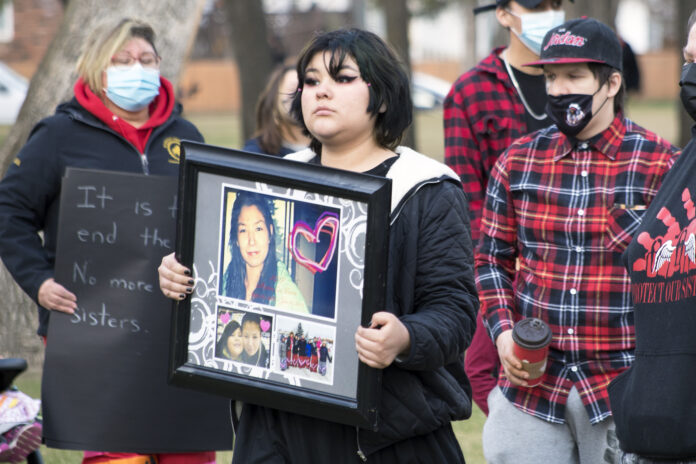
One of Dorothy Burn’s biggest wishes in life is that she had the chance to get to know her niece.
Monica Lee Burns was in her late 20s when she was found dead roughly 15 km north of Prince Albert on Jan. 17, 2015. On Wednesday, Dorothy and her husband Ron were among the dozens of friends and family members who gathered in Kinsmen Park to remember Monica and the many other Indigenous women who were murdered.
“I’m sorry to say I barely knew her,” Dorothy said when asked about her niece. “I knew the parents. She was very lost in her way of life, so we never really got to know her that well. She was kind of on her own…. I wish I’d got to know her better, but like I said, it was very difficult.”
Monica was just one of 41 Indigenous women who were murdered in 2015. Her killer plead guilty to manslaughter and one other charge, and received a 13-year sentence in November 2016.
For Monica’s friends and family, Wednesday was a time to comfort and support each other, but also continue looking to find ways to keep other Northern Saskatchewan women safe. Both Dorothy and Ron say there’s no quick fix to reducing the violence against Indigenous women, but it starts with education, mutual respect, and community support.
“I think it’s up to the communities to help their young people, to steer them in the right direction,” Dorothy explained. “The drugs and alcohol, like I said, it’s like an epidemic, and how do you fight that? How do you control that? It’s up to individuals to help each other, and the elders to help the young people.”
Memorials, marches and remembrance ceremonies were a bit muted compared to previous years, but Prince Albert residents still came out to Kinsmen Park in sizable numbers to mark the National Day of Awareness for Missing and Murdered Indigenous Women and Girls.
Event organizer Sara Daniels, Monica’s sister, said they originally anticipated a smaller gathering, never thinking so many people would turn up. She was encouraged to see so much community support during a difficult time.
“It’s amazing,” she said. “Yesterday, I just asked my late sister’s daughter, Dannataya, if she wanted to do a walk with just herself, myself, and my three girls, and she said, ‘yes.’ That’s what it started out as—just the five of us. This support, it’s just amazing.”
Daniels says she’s worried Indigenous women are just as much at risk now as they were when her sister was killed in 2015. However, she’s also confident Canadians have realized just how severe the problem is. Now it’s just a matter of taking that awareness and turning it into action.
“It’s powerful to come together in a good way,” she explained.
The National Day of Awareness has its roots in the Red Shirt Project, which was started by Manitoba-based Métis artist Jaime Black in 2010. Black wanted to create a visual response to the hundreds of Indigenous women who were murdered or reported missing every year, so she began collecting 500 red dresses.
Roughly 100 of those dresses were placed in the trees throughout downtown Winnipeg. The rest were used as part of an art exhibit at a Winnipeg gallery in an attempt to bring more intention to the large amount of violence directed at Indigenous women and girls.
Indigenous women are seven times more likely to be murdered than non-Indigenous women, according to the Native Women’s Association of Canada (NWAC). The organization created a database to track the number of missing and murdered Indigenous women in Canada more than a decade ago.
On Wednesday, NWAC president Lorraine Whitman said it’s encouraging to see growing awareness about the problem, but Canada’s elected officials need to do more to address the problem.
“The deaths and disappearances continue in this country, and indeed, across the Americas,” Whitman said in a media release. “Eleven years (after the first Red Dress Day) the government has produced no national action plan to stop the violence. Eleven years later, women are no safer than they were on that day when Ms. Black hung that first dress in Manitoba.”

